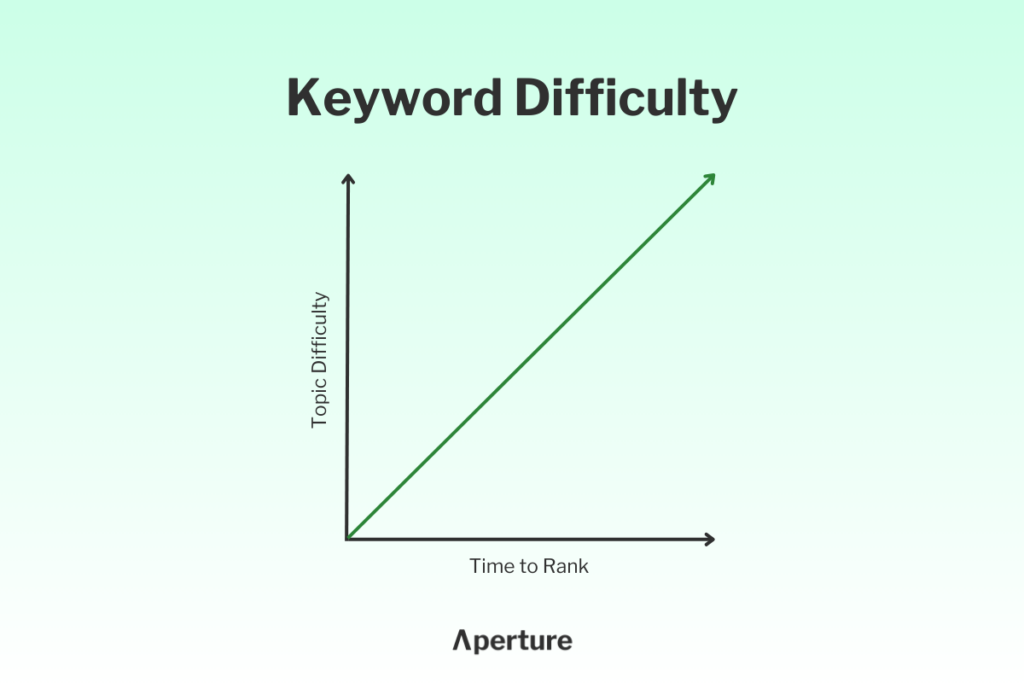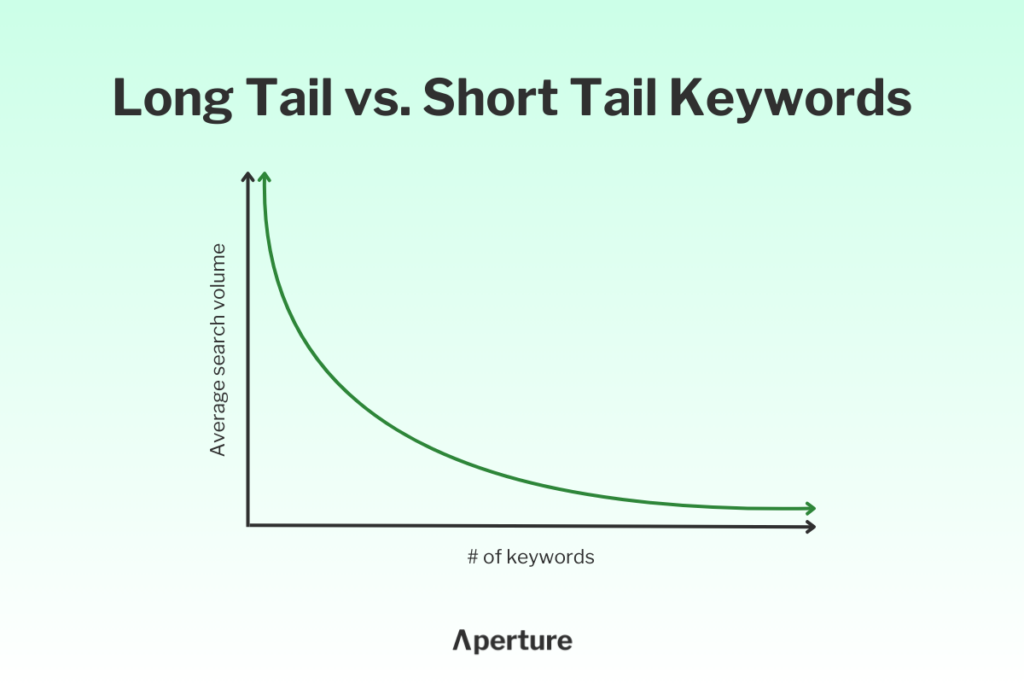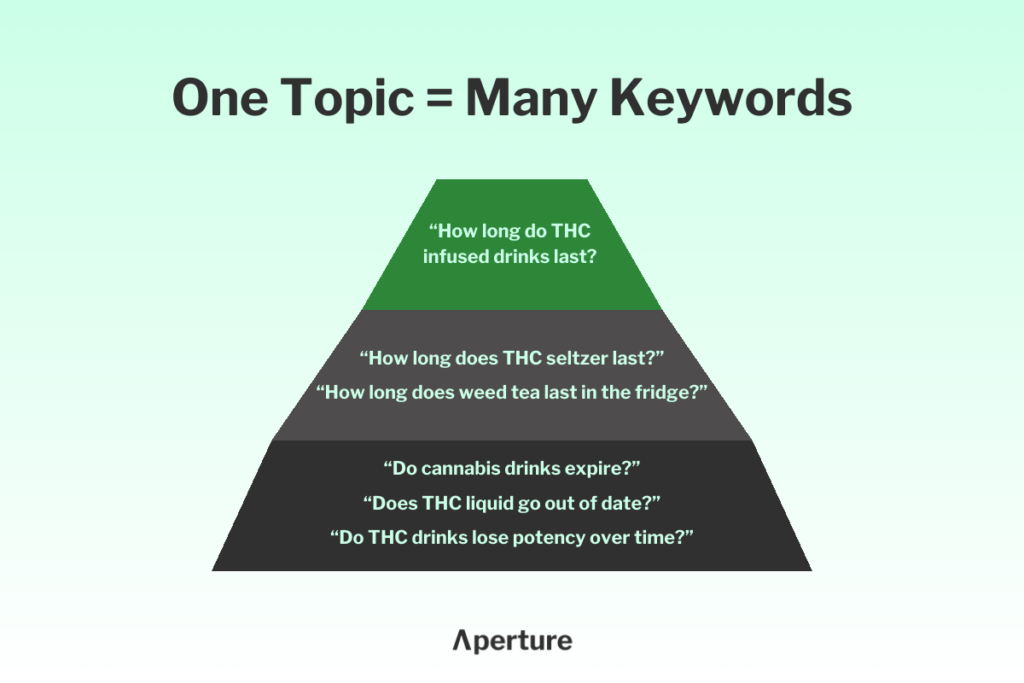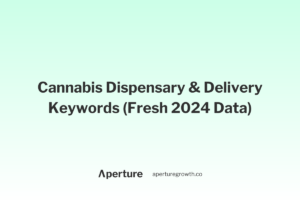Choosing the right keywords is the difference between spinning your wheels and seeing good results from your SEO strategy.
In this article, we’re going to present a battle-tested process you can use to find CBD SEO keywords that drive revenue and build authority for your brand.
We’ll also discuss how to do CBD keyword research for the specific types of pages that brands commonly need to optimize and/or build as part of their SEO strategy.
Let’s get into it.
What are CBD Keywords & Why Do They Matter?
Keywords are phrases people type into search engines (like Google) to find what they’re looking for. CBD keywords are keywords that pertain to the CBD industry: these are the ones you’ll be focused on for your brand.
CBD keywords are important because they tell you what people are searching for and how much. This allows you to create pages that rank for these keywords, and therefore make you visible to the people searching these terms.
People perform searches to accomplish a variety of things, be it to buy a product or get an answer to their question. Therefore, there is an extensive CBD keyword landscape: a good SEO strategy makes you visible for the keywords in the landscape that indicate someone is a potential customer of your business.
CBD Keyword Research: Key Concepts to Understand
Before we dive into the CBD keyword research process and look at how to find keywords for different types of pages, we’re going to cover a few SEO concepts that will make it easier to do keyword research for your business.
Search intent
Of all the concepts we cover here, search intent is perhaps the most important.
Simply put, the search intent of a keyword is the intention someone has when searching that phrase. In other words, it’s what the searcher hopes to accomplish.
Understanding the search intent behind different keywords allows you to do two things:
- Find keywords that indicate someone is potential customer and wants to buy products like the ones you sell or learn more about them
- Be the best result for the keywords you want to rank for, because you’ll understand what someone is wanting when they search those keywords
The easiest way to figure out what the search intent behind a keyword is is simply to look it up and see what’s ranking.
Google ranks pages that meet search intent; reverse-engineering the current results gives you a pretty good idea of what you need to do (and what opportunities you have to do better than what’s ranking).
Volume
Search volume is the metric used in most tools to indicate the number of searches a keyword gets each month.
It’s fairly intuitive, but the search volume of a keyword gives you an idea of the kind of traffic you can hope to bring in if you rank.
Of course, you won’t get all the traffic even if you do rank #1 (you’ll get 30-40%), and the presence of various elements (or lack thereof) on the search engine result page (SERP) will influence how much traffic you get.
Still, search volume is an important metric to factor into your planning.
Competition/difficulty
Keyword difficulty (also called competition in some tools) is a metric that indicates how difficult it will be for your brand to rank for a keyword.
It varies by tool (we use SEMrush), but keyword difficulty is often based on the number of backlinks sites that are currently ranking have.
Backlinks are an authority signal, and generally, competitors with more backlinks are more difficult to topple than competitions with fewer backlinks.
Difficulty is an important metric for newer brands to consider, as more difficult keywords will take much longer to rank for.
But as your brand gains more authority, it becomes increasingly irrelevant, especially for keywords that are part of topics for which you’ve already built some authority.

Topical authority is a metric that indicates how much authority your website has on a topic. You build this authority by writing high-quality content on a topic, with topical authority increasing as you cover the topic in more depth.
While not an official metric, it’s a phenomenon that’s been observed in how Google ranks sites.
The benefit of building authority on a topic is that it becomes easier to rank additional pages for keywords related to that topic. This benefit is especially powerful when it comes to ranking for lucrative product-related keywords.
Topical authority can be leveraged to outrank websites with more backlinks, as authority in a specific area often beats overall authority.
Long tail vs. short tail
The long-tail vs. short tail terminology refers to a distribution in business in which, as the number of items in demand goes up, the popularity of each item goes down.
This analogy is applied to the keyword landscape, in which a large number of people search for a (relatively) small number of terms, but there are very large numbers of terms, each of which receives fewer searches.
Short-tail keywords (we refer to them as “head keywords”) tend to be shorter in length, have very broad search intent, have high search volume, and be more competitive.
Long-tail keywords tend to be longer, have a very specific search intent behind them, have lower search volume, and be lower-competition.
Generally, within a head topic, there will be a few broad, high-volume head keywords, and then a larger number of long-tail keywords.
You’ll see this pattern emerge as you research various topics in a keyword tool.

Topics vs. keywords
When you do SEO, you’re targeting topics, not keywords. A keyword is a single phrase, whereas a topic is a group of keywords that all mean the same thing.
This means you’ll want to build one page per topic, not one page per keyword. The purpose of keyword research is simply grouping these keywords together, and then finding the head keyword within the topic to optimize for.
If you do this right, you’ll be able to rank for every keyword within the topic. For example, by ranking for “How long do THC-infused drinks last,” you’ll get traffic from keywords like “do THC drinks expire?,” “do THC drinks go bad?,” and so on.

Bringing it all together
The concepts we discussed above are really only useful if they’re used together. Because of this, here are a few conceptual takeaways you need to internalize before we move on:
- You need to target keywords with search intent that indicates someone is a potential customer of your business.
- The keywords you pick should offer a good balance of volume and difficulty so that they’ll bring traffic to your site, but won’t take too long to rank for.
- Your SEO content strategy should help your site build topical authority on the topics most important to your business, i.e., those that map to your product line. Doing this will help you rank more easily for these valuable terms.
- Starting with long-tail keywords allows you to get easier rankings in the beginning and build topical authority, which then allows you to target progressively more difficulty, higher-volume keywords
- When you’re considering the volume and difficulty of a keyword, be sure you’re considering the total stats across all keywords in that same topic. This will allow you to make more informed decisions about what keywords to target and prioritize them.
The CBD Keyword Research Process
With core CBD keyword research concepts in mind, let’s have a look at the basic process you can use to uncover winning keyword ideas:
- Have a topic in mind: This topic will depend on your target audience and the type of page you’re doing keyword research for. For example, if you’re researching keywords for your product pages, the topic you’d input into an SEO tool would be your product itself. As you research keywords, you’ll come across additional ideas. But to start, you should have a rough idea of the topic you want to show up for – this should already be hammered out in your CBD content marketing strategy.
- Search your topic and discover your keyword options: With a topic in mind, put it into a keyword research tool and see if people are searching for it and if so, how. You’ll also want to look at how many unique topics are present and the search volume and difficulty of the keywords.
- Check topics and search intent: If you input a broad keyword, you’re going to see many subtopics. Search these subtopics individually and compare the results. If they’re the same, every keyword you see is part of the topic you searched. If they’re not, there are multiple unique topics within the head topic, and each will need a different page. Check the results and see which ones match the page you’re trying to build or optimize (if you’re researching keywords for blog posts, you can simply write a post for each topic). From here, refine your search so you’re only seeing keywords that are a part of the topic you want. This will allow you to get accurate volume and difficulty data for prioritization.
- Make note of keywords: Once you refine your search and get a look at only the keywords that are part of the topic you care about (based on your topical categorization and search intent check), write down the head keyword for every topic you research in a spreadsheet, along with its volume and difficulty data.
- Repeat the process: Repeat this process to find a keyword for every page you need to optimize or build.
- Prioritize: Prioritize optimizing or building the pages based on the volume and difficulty of head keywords (highest volume, lowest difficulty first).
This is a rough process that’s applicable to researching keywords for most types of pages. But in the next few sections, we’ll go deeper on doing CBD keyword research for specific page types.
CBD Category Page Keyword Research
Category pages are pages that house a category of products (e.g. CBD gummies), as opposed to a single product (e.g. 50mg CBD gummies).
Here, keyword research is all about finding the best term to optimize your existing product category pages for. After that, you can find additional category opportunities.
For each category page, your goal is to find a keyword that:
- Accurately describes your product category (i.e. people searching this keyword want to view product category pages like yours)
- Is achievable from a difficulty standpoint (to start, we say 30 or below)
- Has a decent amount of search volume (to start, at least 200 searches/mo)
To find keywords, simply search each of your categories in a keyword research tool and then filter the results.
Let’s say you sell the following types of products:
- CBD gummies
- CBD oil
- CBD capsules
- Delta 9 THC gummies
- Delta 8 THC gummies
We’d just type each category into our tool.
In this example, we’ll start with our CBD gummies category (we’ve filtered out branded keywords):

As you can see, the term “CBD gummies” has a difficulty score of 98 – probably too difficult in the beginning.
You’ll see this with many of the main category keywords. Because many CBD companies sell the same types of products, you’ll be competing against the entire industry if you try to rank for “CBD gummies” or “CBD oil.”
Thankfully, there are a couple of workarounds. If the obvious category keyword is too difficult, you can:
- Find a long-tail version of that keyword that’s more specific and lower-difficulty.
- Find a different way people are searching for your category.
We’ll demonstrate both.
Workaround 1: Finding Long-Tail Category Keywords
Finding a longer-tail keyword that’s more specific and has lower competition is the first thing you can try.
Scrolling down in our “CBD gummies” search, we can see the keyword “CBD gummies for stress.”

At a 26 difficulty score, it’s noticeably less competitive “CBD gummies.”
This means we’ll want to refine our search to see all the keywords that are part of this topic.
If we search “CBD gummies for stress,” specifically, we can see this keyword gets 2,210 searches per month. Not bad.

But we also need to make sure the intent behind this keyword is to explore a product category, as opposed to a specific product page or a blog post.
If we check the results for this keyword, we can see a category page ranking #2.

This indicates that the search intent behind this keyword is likely to explore a category page, as opposed to a specific product page or a blog post.
There are product pages ranking, but that’s likely because not many companies have built category pages for this keyword.
By building a category page that targets “CBD gummies for stress” instead of “CBD gummies,” we’ll get an easier ranking that still drives substantial revenue.
Workaround 2: Finding Other Ways to Describe the Category
For some broad category keywords, there are plenty of long-tail versions to target. In many cases, it’s worth targeting all of these variations with separate pages.
But for other keywords, these options don’t exist. In this case, you can find easier opportunities by targeting an alternate description of your category.
For CBD gummies, one variant that comes to mind is CBD edibles.
An edible is any product you can eat, so this product category includes things like candy. But it also includes gummies, so you could rank a category page for it if you have enough variety.
Let’s try it:

Still difficult to rank for, but not as difficult as “CBD gummies.”
In many cases, you’ll want to build additional categories so you don’t have to optimize your main categories for very specific keywords – this is a user experience concern.
But by using these workarounds, you can find viable category keywords that you can rank for and profit from.
CBD Product Page Keyword Research
Product pages are the pages on which each of your products live. They’re also the place where many add-to-cart actions happen.
Most product keywords don’t get near the search volume category keywords do (it stands to reason that people go general → specific when purchasing), but it’s still worth optimizing your product pages for them.
They’re specific, so they convert well, and they’re, in many cases, fairly easy to rank for.
The goal with product page keyword research is to find a keyword that:
- Accurately describes your product (i.e. the search intent is to buy a product like the one you sell)
- Is achievable from a difficulty standpoint
- Has a decent amount of search volume
For this example, let’s say you sell a sleep gummy that contains 20mg of CBN and 5mg of CBD in each piece.
The obvious play here might be to try and rank for “CBN gummies” (this might normally be a category keyword, but most companies don’t sell more than 1-2 types of CBN gummies, so it’s not – as of now).
Let’s look at it:

At a difficulty score of 36, this keyword isn’t too bad.
But what if we were to go more specific and target “CBD CBN Gummies,” which not only describes your product, but is more specific?

At 25, the average difficulty of this keyword is quite a bit lower, and it still gets nearly 2,000 searches per month.
For a newer brand with less authority, this tradeoff may well be worth it.
As with category pages, finding keywords for your product pages is all a matter of getting creative and thinking about all the different ways people could be searching for the products you offer.
CBD Blog Content Keyword Research
Writing blog content for your CBD brand is important for a variety of reasons, but the two key ones are:
- Writing blog content about topics that map to your product line helps you build authority for those topics, which helps your category and product pages rank better.
- Blog content helps you reach potential customers before they’re ready to buy. By converting these people to email signups, they’ll be more likely to buy from you down the line instead of a competitor.
Finding CBD blog topics is fundamentally different from category and product keyword research. When you’re finding keywords for existing pages, your goal is simply to find the best-fit keyword.
But with blog content, you’re starting from scratch and could, in theory, target any keyword you want.
You shouldn’t write about just anything, though: you need to write about topics that relate to your products so you can build authority.
Finding topical silos
Topical silos are the overarching topics you need to build authority on in order to rank your category and product pages.
Generally, CBD brands need to think about topical silos in terms of the different product ingredients, rather than the different product types.
This is because most companies sell a single cannabinoid in five different delivery methods (e.g. CBD gummies, CBD oil, CBD topicals, CBD drinks, CBD vapes), not a single delivery method with five different cannabinoids (CBD gummies, delta 8 gummies, delta 9 gummies, THCv gummies, CBN gummies).
Therefore, you need Google to see you as an authority on the ingredients themselves.
So if you sell:
- CBD gummies
- CBD oil
- CBD capsules
- Delta 9 THC gummies
- Delta 8 THC gummies
Your topical silos will be CBD, delta 9, and delta 8.
Finding blog keywords
Within each topical silo, you’ll want to target keywords that indicate someone is a potential customer. You can find ideas using the marketing funnel:
- Top of the funnel (TOF): People in this stage are aware of CBD, delta 9, and delta 8, but not actively researching how it can solve a pain point they have.
- Middle of the funnel (MOF): People in this stage are actively researching how CBD, delta 9, or delta 8 can solve a pain point they have.
- Bottom of the funnel (BOF): People in this stage are looking to buy CBD, delta 9, or delta 8.
The bottom-funnel keywords in each topical silo are already being covered by your category and product pages.
But to be visible in the top two stages of the funnel, you’ll want to target TOF and MOF keywords, which will be information-focused, with helpful blog content.
Going with a middle-of-the-funnel example, “CBD for anxiety,” we get the following:

Obviously, quite a few people are searching for information related to using CBD for anxiety. But many of these keywords have fairly high difficulty scores.
This means we’ll need to be more specific.
What if we searched, “CBD vs CBG for anxiety,” where people are trying to compare the two cannabinoids for this use case?

Only 190 searches per month, but much easier to rank for. And it still builds topical authority for CBD and contributes to the rankings of those category and product pages. There are always easier subtopics you can write about.
To find additional content ideas within each stage of the funnel, do the following:
- Search the head keyword of the topical silo (e.g. “CBD”) and filter by the lowest amount of search volume. This will let you find hyper-specific, low-competition keywords that people are searching for.
- Identify patterns of keywords that indicate a certain type of intent that tends to live in one stage of the funnel. For example, the keyword pattern “cbd for [issue]” is indicative of the intent to explore how CBD can help with different problems. By typing “cbd for” into your keyword tool, you can find dozens of content ideas within the middle of the funnel.
- Repeat this process until you find keywords that cover the funnel of each of your topical silos, and from different angles.
Researching keywords for your blog content can be overwhelming because there are so many topics you can write about.
But by focusing on your product line and thinking about the funnel, you can narrow things down enough to start finding content ideas that make sense for your business.
CBD Local SEO Keyword Research
If you don’t sell online but instead want to use SEO to get people into your brick-and-mortar CBD store(s), there’s an additional type of page you’ll want to consider creating: location pages.
The purpose of this local SEO tactic is to rank for queries that indicate someone wants to visit a CBD store in an area where you have a location.
The keyword research here is very straightforward. Typically, the keywords you’ll target with these pages follow this pattern:
- “cbd [location of your store]” or “cbd store [location of your store]”
- CITY EXAMPLE: “cbd store plano tx”
- NEIGHBORHOOD EXAMPLE: “cbd store french quarter”
Generally, the right keyword will be intuitive. However, you’ll want to research these keywords to ensure they really do indicate someone wants to visit a CBD store and that they’re a good opportunity for your brand.
This extra bit of research is valuable, because in some cases, you might have better luck ranking for neighborhood search terms than city search terms.
Here’s the process we use to find the best-fit keyword for each location page:
- Input different variations of your keyword into a keyword research tool like SEMrush
- Filter by lowest competition/difficulty score
- Put keyword ideas into your spreadsheet
- Check the search results for each keyword and throw away that ones that don’t return CBD store location pages or home pages
- Of the remaining keywords, choose the one with the best balance of high volume and low competition
Conclusion: Intent Over Everything
No matter what part of your site you’re researching keywords for, you need to focus on understanding the search intent behind the keywords you choose.
This will help you ensure that you’re choosing the right keyword for the page, and that once you do, you’ll be able to create content that satisfies the intent and earns you a top ranking.
If you’re ready to move from keyword research into building pages, check out our CBD SEO strategy guide and learn what you need to do to start ranking.
Learn More or Work With Us
- Our services. We offer revenue-focused CBD SEO services to businesses looking to grow their top line revenue and improve their profit margins. We help CBD businesses dominate nationally and locally, and we’d love for you to be our next success story.
- Our blog. A collection of articles that will help you grow your CBD business with SEO.
- Our YouTube channel. Videos detailing SEO strategies and tactics to help cannabis and CBD businesses grow.
- Our LinkedIn. SEO and marketing insights for cannabis brands six times a week, straight from Wells, our founder (that’s me).




